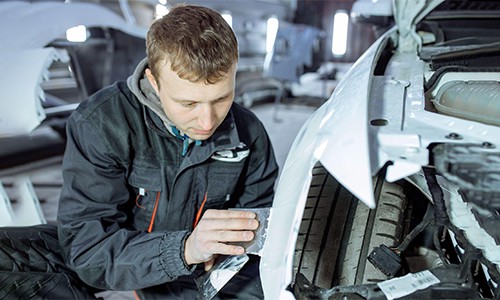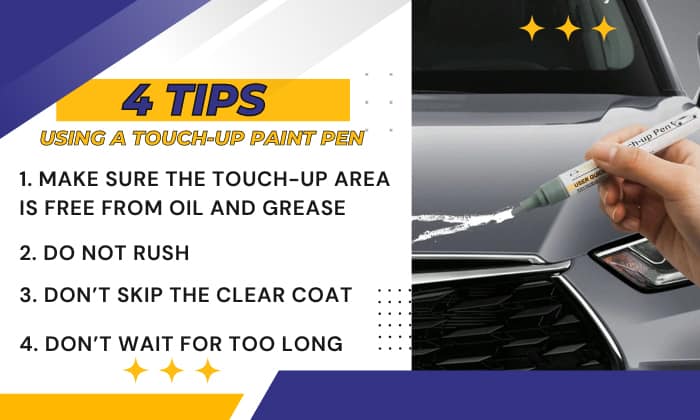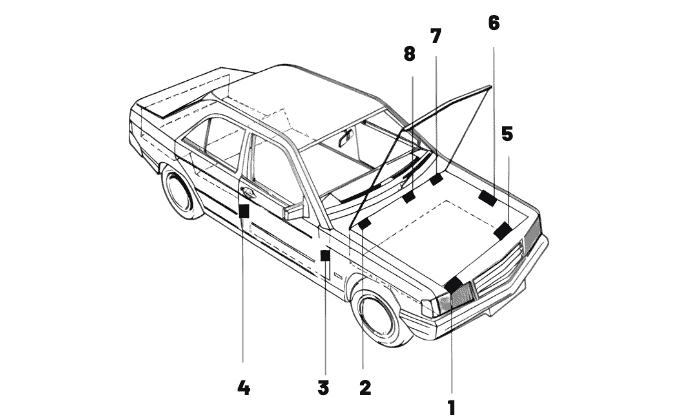Getting paint scratches and chips is inevitable. It’s part of the wear and tear of every paint job that you have to be prepared for. But did you know that you can actually touch up those chips and scratches with a paint pen?
In this article, we’ll learn how to use a touch-up paint pen and discover how you can effortlessly restore car scratches, stone holes, and dings without spending much.
We’ll also get familiar with different types of touch-up paint pens and give you a simple guide in choosing the right product.
Table of Contents
Step-by-step to Use a Touch-up Paint Pen
Before we go through the guide, let’s first learn the different formats, colors, and systems of touch-up paint pens to help you pick the best touch-up paint pen for your application.
Choosing the Right Touch-up Paint Pen
1. Touch-Up Paint Pen Format
- Marker Type—easy to use, this works like a regular paint pen. Some may feature a piston-like tip that needs to be prime before application.
- 2-in-1 Type—it either comes with a fine metal nib and a brush tip or a dual-ended In the latter case, one end will contain the colored paint, whereas the other is the clear coat.
- All in 1 Type—it can be in the form of a kit or a single touch-up paint pen with an abrasive tip, 2 applicators, and a clear coat.
2. Color Matching
Finding the exact color match can sometimes be more tricky than learning how to use a paint pen on a car. To do so, look for a supplier who offers OEM or precision color matching.
Another option is the manufacturer’s paint pen. This is sold by brand manufacturers themselves, so you’re guaranteed to get a perfect color match.
3. Paint System
While some certain touch-up paint pens only require one step, they may not be very long-lasting. As such, you should pick ones that require a full three-step process. This includes treatment and protection that is completed by priming, applying the base coat, and a clear coat.
Step-by-step Guide
1. Preparation
1. Cleaning
It is strongly advised to clean your car or at least the area to be treated thoroughly with wax remover before applying paint or doing a touch-up. If you don’t have a wax remover, cleaning detergent will suffice.
2. Sanding, Filling, and Priming
If the target area is already rusted, you may want to sand it out with a 3000-grit sandpaper or use a rust converter. However, should the scratch has chipped off the whole paint layer or penetrated down through the surface, you will have to use a primer or body fillers to car chips.
Tip:
- Use painter’s tape to isolate the touch-up area. If you are working with car paint, use automotive-grade tape.
- Choose your work location Avoid working under direct sunlight and in a humid area.
- Practice applying the paint pen before you start the actual application.
2. Application
After your surface is clean, treated, and dried, it’s time to start touching up.
1. To reactivate the paint and ensure the pen produces a uniform color, give it a good shake for about 1 minute.
2. Check and test the pen on cardboard for color and consistency.
- Piston type—prime it first by depressing the tip onto a hard surface until you get your desired consistency. Wipe clean any excess ink from the tip before the actual application.
- Metal tip—squeeze the body lightly to release the paint.
- Brush type—can be applied directly as long as the paint is not dried.
3. Lightly dab the tip of the touch-up paint pen or the brush on the target area. Do not get tempted to glide it over to car scratches like a regular paint pen.
4. If another coat is necessary, let the first one dry for about 20 minutes before you apply touch up paint pen again. 2 coats should be enough.
5. Make sure the base coat is of the same level as the original paint or slightly above it.
6. Smooth out touch-up paint using a rubbing compound. Pour some onto a clean microfiber cloth and rub it on top of the touch-up area.
7. Once you are satisfied with the color, let it dry completely and leave it for a few hours or check the label for the recommended drying time.
3. Finishing Touches
1. Apply a clear coat. You can dab up to two coats, but be sure to wait for at least 10 minutes for the first coat to dry.
This step is optional and may not be that necessary. However, having an extra clear coating will give your touch-up a glossier finish and UV protection. For some kits, the clear coat is also designed to aid color matching.
2. Reapply the rubbing compound until you get a glossy look. Always use a fresh and clean cloth to avoid scratching your newly repaired surface.
3. Wax your car to get a full glossy finish. Do note that waxing right after the touch-up is not recommended.
You will have to let the touch-up fully cure. This will take at least 2 days, but for better results, let the paint set for a week up to a month before waxing.
Other Tips
- Make Sure the Touch-Up Area Is Free From Oil and Grease
Not all oily substances can be removed with simple soap and water. Any oil will prevent your paint from truly staying on. Use a grease remover to ascertain that your surface is oil-free.
- Do Not Rush
Like any painting work, when using a touch-up paint pen, rushing will only result in a bad finish. Do not rush the required drying time in between coats.
To be clear, you should wait 20 mins to 24 hours for the primer, base coat, and clear coat. You can use a blow dryer to shorten the waiting time.
- Don’t Skip the Clear Coat
To maximize the protection and lasting of your touch-up paint, adding this extra step is exceptionally useful.
- Don’t Wait for Too Long
Schedule a touch-up right away while the defect is still small. This will prevent the damage from getting worse and incurring more expenses.
An automotive touch-up paint pen is a very cost-effective treatment, but applying a touch-up paint pen is only limited to small defects.
Identifying the Vehicle’s Color Code
The best way to get an exact color match is to know your car’s color code. This can be found on the inside of the door jamb on the driver’s side, glove box, wheel well, or the passenger’s sun visor.
Let’s say you’re looking for a Toyota touch-up paint pen for a Toyota Camry. In this case, the 3-letter code is on the driver’s door jamb. If the code, for example, reads 3T3, then the touch-up paint should be Toyota Ruby Flare Pearl.
Alternatively, use the VIN, although the process will be a little more complicated, as this number doesn’t inherently indicate the car’s color. To be clear, it only tells you the manufacturer, model, production year, and the trim level. As such, picking paint color solely based on VIN may not always be accurate.
In any case, the VIN is normally found on the certificate of registration and on the car stickers located near the windshield or dashboard.
FAQs
Can I use a touch-up paint pen on any type of vehicle?
Not really. You have to be aware that not all touch-up paint pens are compatible with every type of paint and finish that a particular vehicle has.
Generally, you can use lacquer touch-up paint for glossy surfaces and a matte type on vehicles with a flat finish and surfaces like the bumper or interiors.
Ultimately, consult your dealer. Certain brands like Toyota offer touch-up paint pens that exactly match the original paint of your unit.
How long does it take for touch-up paint to dry?
Several factors can affect the drying time of a touch-up paint pen. These are the consistency of the paint, how thick the coating is, and the environmental condition.
Typically, you would want to leave it for at least 24 hours just to make sure it is fully dried. Some touch-up paint can dry within a few hours after application, but then again, it’s better safe than sorry.
How to get rid of the dried-out or excess paint from touch-up paint pens?
You can scrape it off carefully using a toothpick; never force it, as this will only cause a bigger problem. Another way is to use solvents like mineral spirits and lacquer thinners. Apply it on a cotton swab or rag and gently pat it on the dried paint.
Conclusion
Learning how to use a touch-up paint pen is not that hard. Touch-up paint pens are cost-effective, simple, and easy to find.
However, it is important to follow the instructions indicated by the manufacturer to make sure you get the most out of it. Additionally, choose a pen type that you are most comfortable with without compromising durability.

Art has always been a part of my life; it influences my upbringing and later my career choice. For me, it is always a part of my parenting technique. So for whichever purpose that you come to art, you can start here with us.








